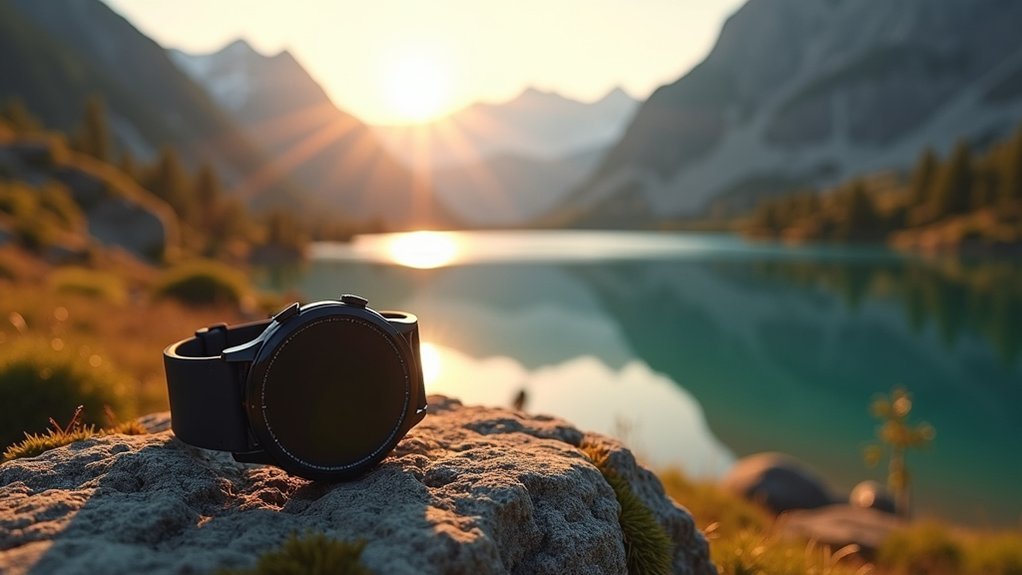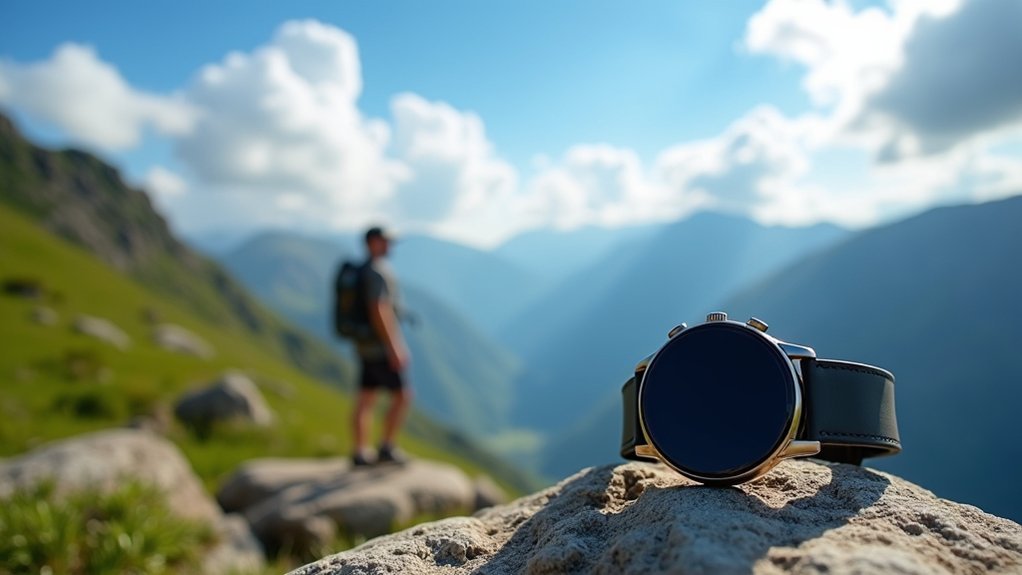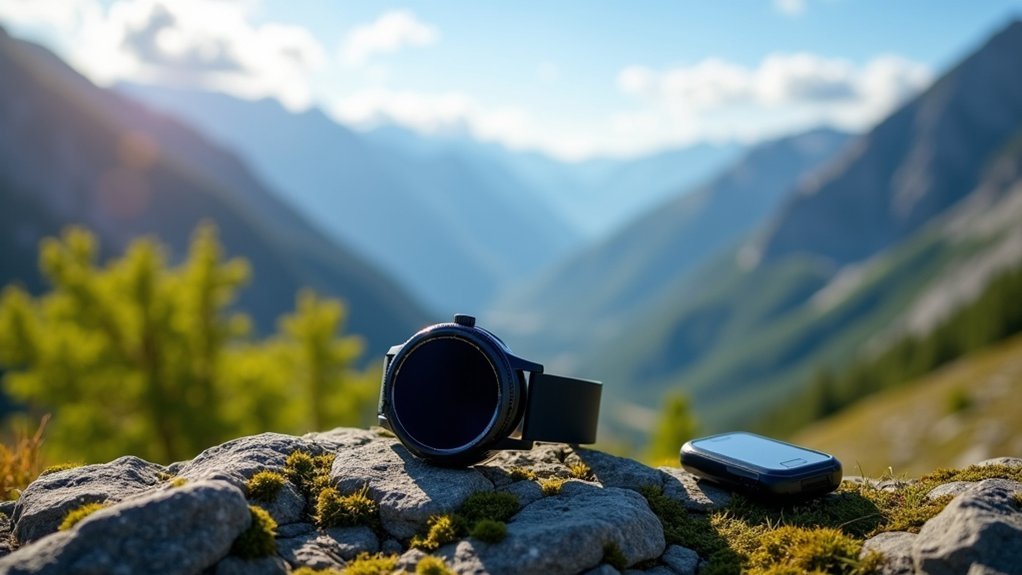When choosing between GPS and GLONASS for outdoor tracking, consider: 1) GPS offers 3.5-7.8m accuracy while GLONASS provides 5-10m; 2) GLONASS excels in higher latitudes and urban environments; 3) Using both systems increases battery drain by 1% per hour; 4) GPS-only is sufficient for open areas, but dual systems help in forests and mountains; 5) Match your satellite settings to your specific activity. The right configuration can dramatically improve your adventure tracking performance.
Understanding GPS Vs GLONASS Positioning Systems for Outdoor Watches

When comparing GPS and GLONASS for outdoor activities, understanding their fundamental differences helps you make better choices about your navigation technology.
GPS, America’s satellite system, delivers reliable worldwide coverage with 31 satellites, while Russia’s GLONASS excels at higher latitudes where GPS may struggle.
Navigation systems excel in different regions—GPS offers global reliability while GLONASS provides superior performance in northern territories.
While GPS alone provides decent accuracy, adding GLONASS considerably improves positioning reliability in challenging environments like dense urban areas or under partial tree cover.
The combination increases your total visible satellites, resulting in faster location fixes and reduced positional drift. Tests show that dual-system tracking can reduce drift from 200 meters to around 70 meters in difficult conditions.
If you’re hiking in northern regions or areas with obstructed views, you’ll benefit most from enabling both systems on your outdoor watch.
Modern GPS watches like the Garmin Forerunner 965 offer multi-band GPS capabilities that significantly enhance tracking accuracy for serious athletes and adventurers.
How Satellite Coverage Affects Your Tracking Accuracy in Different Terrains
Satellite coverage directly impacts your tracking accuracy across different outdoor environments, creating significant variations in positioning reliability depending on where you’re adventuring.
Understanding how these systems perform in your specific terrain can help you choose the right settings for your outdoor watch.
- Open areas: Both GPS (3.5-7.8m accuracy) and GLONASS (5-10m) perform near their maximum potential with clear sky views, with GPS offering slightly better precision.
- Urban environments: Buildings block and reflect signals, degrading accuracy; using both systems together provides more available satellites and improves positioning. Combining GPS with Galileo can deliver even greater accuracy for navigating complex city landscapes.
- Forests and mountains: Signal attenuation reduces accuracy for both systems, but GLONASS’s higher-latitude satellite distribution may provide advantages in rugged terrain.
- High latitudes: GLONASS outperforms GPS above 60° latitude due to its orbital design that prioritizes northern/southern regions.
Battery Life Trade-offs When Using Multiple Navigation Systems

Balancing accuracy with endurance presents a significant challenge when using multiple satellite navigation systems simultaneously on your outdoor devices.
When you enable both GPS and GLONASS, expect an additional 1% battery drain per hour compared to GPS alone, bringing total consumption to 5-6% hourly.
For short activities under 4 hours, this difference is often negligible. However, during extended adventures like hiking or ultramarathons, these power demands add up quickly.
You’ll see the most benefit from multi-GNSS in challenging environments where the improved accuracy (reducing drift from 200m to 70m) justifies the battery cost. Testing has shown that position data points are more tightly grouped with GLONASS enabled, resulting in better stability of readings.
To extend battery life, consider:
- Using longer intervals between GPS fixes
- Disabling secondary satellite systems in open areas
- Activating battery-saving modes like UltraTrac
- Turning off unnecessary sensors
Optimizing Satellite Settings for Specific Outdoor Activities
Choosing the right satellite settings can greatly impact your outdoor navigation experience beyond mere battery considerations.
Different activities benefit from specific GNSS combinations based on your environment and accuracy needs.
- Trail running/hiking: Use GPS + Galileo for precise tracking in varied terrain with better performance in canyons and dense forests.
- Open water activities: Stick with GPS + GLONASS for reliable global coverage and excellent performance at higher latitudes.
- Urban adventures: Switch to GPS + Galileo when maneuvering between tall buildings to reduce multipath errors and improve positioning accuracy.
- Asia-Pacific exploration: Enable GPS + QZSS if your device supports it for enhanced satellite visibility in this region.
Remember that enabling GLONASS alongside GPS provides faster position location in challenging environments where basic GPS might struggle.
Test your device’s different satellite combinations before important events to determine which setting works best for your specific activity and location.
When to Choose GPS+GLONASS and When GPS-Only Is Sufficient

When should you combine satellite systems versus relying on a single constellation?
Choose GPS+GLONASS when maneuvering through challenging environments like urban canyons, dense forests, or mountainous terrain. The combined systems provide better coverage at high latitudes (above 60° north/south) and faster position acquisition with improved signal reliability in obstructed areas. GLONASS particularly excels at latitudes where GPS coverage may be less optimal.
Stick with GPS-only when you’re in open areas with clear sky views, as it typically achieves 5-meter accuracy—sufficient for most hiking, running, or casual maneuvering.
GPS-only devices consume less power, extending your battery life during extended outings. They’re also generally less expensive.
The decision ultimately depends on your location and environment: urban or forested settings benefit from dual systems, while open rural areas work fine with GPS alone.
Frequently Asked Questions
How Do Weather Conditions Affect GPS Vs GLONASS Accuracy?
Weather affects both systems, but GLONASS performs better in high latitudes during storms. You’ll get more reliable positioning using both together, as GPS struggles more with ionospheric disturbances during severe weather.
Can GLONASS Provide Accurate Altitude Data in Mountainous Regions?
Yes, GLONASS can provide accurate altitude data in mountainous regions, but you’ll get better results by combining it with GPS. It often performs well despite multipath issues, especially when using hybrid receivers.
Do GPS and GLONASS Signals Penetrate Water Differently?
No, GPS and GLONASS signals don’t penetrate water differently. Both use similar frequencies (around 1.5-1.6 GHz) and are equally limited to penetrating only a few millimeters to centimeters of water before being considerably attenuated.
How Frequently Do Satellite Positions Update on Consumer Devices?
Your consumer GPS device typically updates satellite positions 1-5 times per second (1-5 Hz). This rate balances power consumption and accuracy needs, while professional GNSS receivers can achieve faster updates up to 20 Hz.
Does GPS or GLONASS Perform Better During Solar Flares?
During solar flares, neither GPS nor GLONASS has a significant advantage. You’ll find both systems are similarly affected by ionospheric disturbances, though using dual-constellation receivers can improve your overall performance during these solar events.
In Summary
You’ve now got the tools to make smarter satellite navigation choices on your outdoor adventures. Remember, GPS-only preserves battery life for most conditions, while adding GLONASS helps in challenging environments. Match your settings to your activity—hiking through canyons needs different coverage than running in open parks. By understanding these systems, you’ll track your outdoor pursuits more accurately and efficiently.





Leave a Reply